|
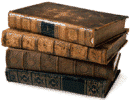  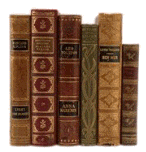 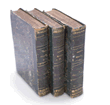
 |
Fashion Theory --
Dr. Lynch and I were engaged by Berg Publishing of Oxford, England to
write a book entitled Changing Fashion: A Critical
Introduction to Trend Analysis and Cultural Meaning. We immersed
ourselves in the study of fashion change, synthesizing it, and writing about it. My
involvement included the psychological, sociological, and cyclical aspects
of fashion change. You can see the cover below so we are getting close. The
book was published in October 2007.
|
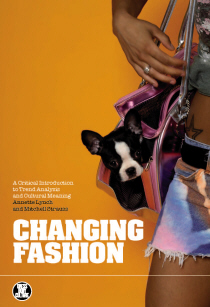
Click above
for details
 |
The Meaning of Dress: Ethnohistorical
Analysis of interrelationship of material culture in the form of dress to
past events.
|
 |
Abstract -
Presentation to the Costume Society of America. Fall 2007.
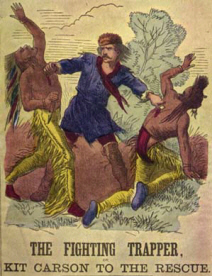
Kit
Carson Dime Novel |
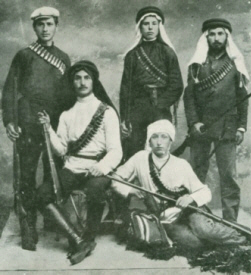
Bar
Giora - The Watchmen |
Leatherstocking in Palestine: Frontier Mythology, Dress, Identity, and the
Founding of Israel
This research
was an interpretation of dress history and its role in reflecting
cultural and social change. More specifically, this work reported
the results of a comparative analysis of the commonalities of dress change
and evolution between the “frontier founders” of the modern state of Israel
and those who participated in the westward expansion of the continental
United States. Exploration of the similarities between dress form and
identity construction of the expansionist “white heroes” in both national
mythologies is the central theme of the work.
An ethnohistorical approach was
used to develop the research data, which included the qualitative techniques
of historical analysis and synthesis, combined with the assessment of
sketches, book covers, and photographs, using established methods of visual
anthropology. Data included the study of original photographs of Hashomer
guards, and interpretations of the Hebrew language Hashomer papers
(Goldstein, 1998; Shafir, 1989), a collection of Israeli documents
concerning the history of the Jewish guards. In comparison, dress artifacts
from the collection of the Autry National Center and the National Cowboy and
Western Heritage Museum were visually analyzed. In addition, the lurid
covers of dime novels, referred to as “blood and thunders” were included in
the analysis as well. The focus of this work was on the history of
participants who functioned within the liminal stage between civilization
and frontier, often finding themselves confronted with violent reaction to
their presence. Included in the analysis of the Americans were such notable
frontiersman as Benjamin Church and Kit Carson.
The context for this research was
an examination of the frontier mythologies created by both nations as a
means of justifying their expansionary land growth and concomitant
subjugation of native populations (Slotkin, 1973, 1992). In both cases
conflict evolved over the struggle to displace non-European, non-White
indigenous natives, residing in the contested wilderness. Violence as a
solution to the impossibility of mutual coexistence between settlers and
indigenous peoples is a central tenet of the frontier mythology, which
contextualizes this analysis. The theoretical construct for this work was
based on Fred Davis’s (1992) theory that fashion emerges out of stress
related to the shifting identities linked to role status ambivalence The
results of this study indicate that both the American frontiersman and the
pre-Israeli Hashomer adopted the dress of their indigenous adversaries as
part of a competitive and aggressive attempt to claim power and status from
them. |
 |
Authenticity and Legends/Mythology of the West -- Images of wild
west mythology abound in our culture defining for many how we view ourselves
in the United States. What's real and what's not? What do we choose to
believe and how do we construct our identities from those conceptions?
|
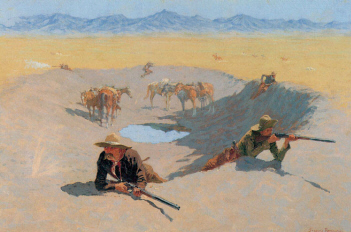
Frederick Remington,
artist |
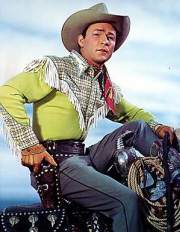
Roy Rogers, Singing
Cowboy |
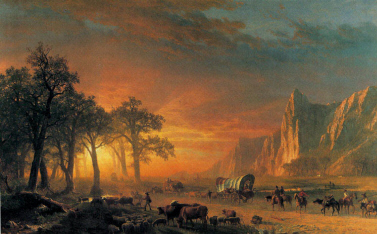
Alfred Bierstadt,
artist |
 |
Abstract -
Presentation to the Costume Society of America. Fall 2004.
I Can See By Your
Outfit That You Are a Singing Cowboy: Analysis of
Dress and Masculinity Construction in Gene Autry’s Wild West Identity
-
Drs. Mitchell
Strauss and Annette Lynch
This research focused on cowboy
mythology depicted in low budget, series Westerns, predominant during the
depression years of the 1930’s in the form of the Singing Cowboys films,
known also as Horse Operas. The Singing Cowboy was an immensely important
cultural figure, representing the fantasies, desires, and ambitions of those
who experienced the economic hardship, dispossession and dislocation of the
era (Stanfield, 2002). The one actor who best defined the essence of the
Singing Cowboy was Gene Autry, around whom this research centers.
The data set for this analysis
included visual and content analysis of a dozen Gene Autry feature-length
films produced in the 1930s, six television episodes produced in the 1950s,
and archives at the Autry Institute for the Study of the American West in
Los Angeles – including the entire 110 item collection of Dell’s Gene Autry
Comic Book covers dating from 1946 to 1955. The comic book, like its
predecessor the dime novel, though not a high form of literature, was a
popular expression of cowboy mythology. Gene Autry’s Comic Book was one of
the most popular of its time and the covers give an outstanding static image
of his cowboy persona. Films, television shows and comic book covers were
examined for the relationship between Autry’s cowboy dress and his
masculinity construction.
Autry was well known for his
rather flamboyant Western dress, an appearance resplendent in comparison to
other male characters in his films. Extravagant dress, combined with his
pleasant, perhaps “sweet” personality created contradictions with the common
view of cowboy masculinity. In fact, film producer, Nat Levine, questioned
whether Autry had the virility to be a bona fide film cowboy (Green, 2002).
Perceptions of masculinity construction are embedded in Wild West mythology,
which is a “vivid and memorable set of hero tales,” based on the “complexly
resonant symbol” of the cowboy (Slotkin, 1998, p. 3.). This image of the
cowboy masculinity, with such hallmarks as earnestness, toughness,
self-discipline, and unswerving purpose remains powerful and culturally
pervasive today (Tompkins, 1992).
Our research indicated, in both
film and the imagery depicted on comic book covers, the creation of
compensatory gender space that functioned to mitigate contradictions between
the Autry Singing Cowboy persona and the more traditional expectations of
cowboy masculinity. For example, in our analysis of comic book covers, we
found a positive linear relationship between rising flamboyance of Autry’s
dress and increasing presence of gender negotiation in the form of posed
violence. We conclude that posed violence was one of several ways in which
Autry counteracted questions of traditional masculinity raised by his
flamboyant dress. |
 |
Authenticity and Folk Music -- Surrounding
the archival image of Woody Guthrie are photographs taken at the 2002 Woody
Guthrie Festival in Okemah, Oklahoma. Dr. Lynch, along with our son Parker,
attended the festival as part of our initial field work focused on dress,
authenticity, and folk music. Following is an abstract of our first
presentation:
|
 |
Abstract -
Presentation to the Costume Society of America. Fall 2002
Conjuring Authenticity: Using Appearance Cues to
Construct Credibility in American Folk Music -
Drs. Mitchell
Strauss and Annette Lynch
Vernacular music, as opposed to the more rigidly
structured forms of classical music, employs a A
musical language that is current, familiar, and manipulable by
ordinary people (Filene, p.4). Folk music is
generally conceived as the purest form of vernacular music; however, the
definition of exactly what constitutes real or authentic folk music has been
subject to debate since early attempts were made to catalog it. In the late
1800's, Francis James Child, established a definitive American folk music
canon derived entirely from British peasant ballads created before the 15th
century. According to Child's any derivation from
his canon suffered from lack of authenticity. Subsequent analysts and
collectors of folk music broadened the scope of what was considered
authentic. Alan Lomax, for example, established additional criteria for
authenticating folk music, including not only the lyrics, but the manner in
which the song was performed, and the appearance of the performer.
The
movement toward including American roots music in the canon of authentic
folk music began in the early 1900s, however the genesis of using white male
working class appearance styles to validate the authenticity of distinctly
American artistic voice dates to the second half of the 19th
century. In the struggle to recognize the unique and significant
contribution of America to the art of poetry, Walt
Whitman self-consciously crafted an engraved daguerreotype for the title
page of his first edition of Leaves of Grass that captured a white
male American working class hero. This visual image of the democratic voice
of America, coupled with a distinct form of free verse, was posed in direct
contrast to images of European poets as coming from an elite educated
class, writing in formal and traditional poetic form.
Whitman's
image of himself became an inspiring appearance style, which when coupled with
his free form verse, becomes emblematic, for singers like Woody Guthrie, of
what it means to be an authentic American artist (Carmen 2000). Central to
this definition of authenticity is performing or writing material that can be
understood by common people, and dressing to symbolize the link of your work
to the real lives of the working class.
The purpose
of our research is to document the role that dress and appearance play in
establishing the notion of authenticity in American folk music. The
theoretical framework we are using is based on Goffman's
work on construction of identity and the role played by dress in developing a
credible identity kit.
|
 |
Dress
Authenticity in Civil War Reenacting -- Below
is a photograph that has been computer altered to appear as a water color.
The photograph was taken by me at the September 1999 reenactment of the battle
of Chickamauga. Though the photograph, before alteration, was a high
quality image, the water color transformation gives a more fitting affect to a
somewhat surreal human endeavor. My research energies
were applied to the study of Civil War reenacting,
particularly issues related to dress authenticity and
underlying meanings and messages associated with Confederate reenacting.
Below the picture are abstracts of my publications in this particular research.
|
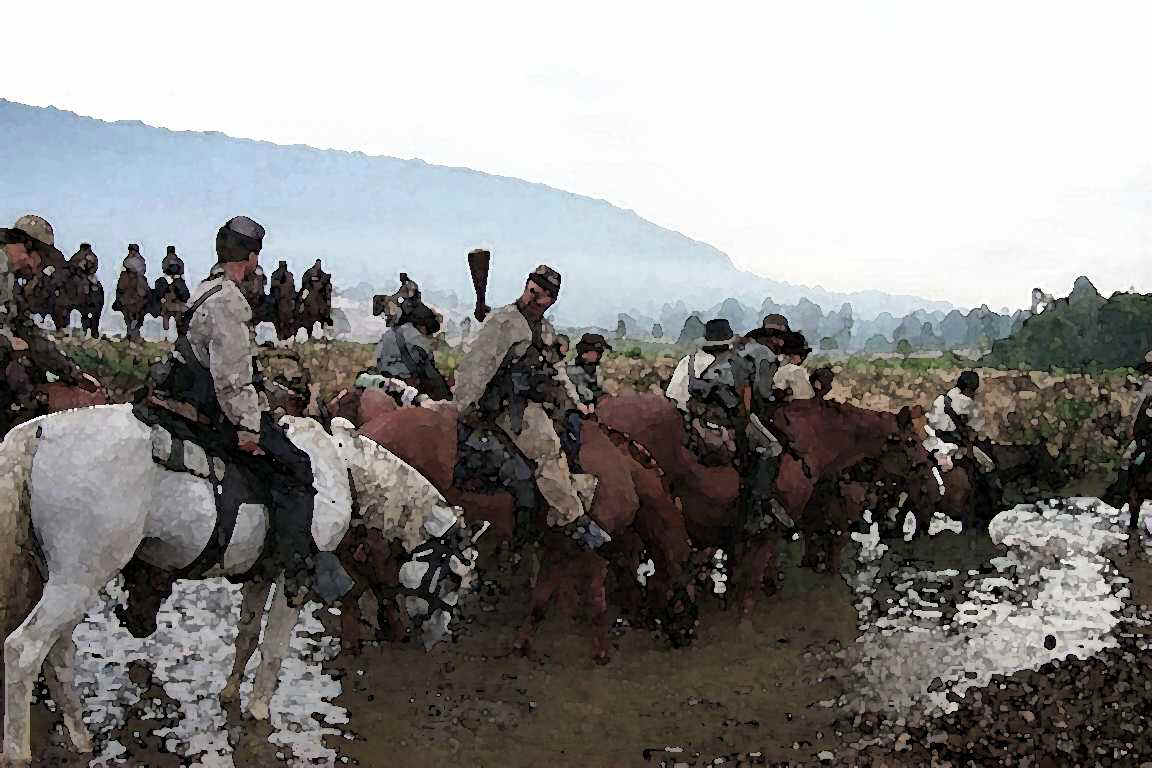
Dawn Patrol at
Chickamauga
Photo by MD Strauss - All Rights Reserved
 |
Clothing and Textile Research Journal
(Volume 19, #4, 2001):
A Framework for Assessing Military
Dress Authenticity in Civil War Reenacting
Abstract
In the United States, hobby organizations
participate in the public reenactment of historical events, emulating the
dress and lifestyle of that time. The most popular is Civil War reenacting,
which reflects the continuing unresolved social and political nature of that
historical event. Interpretation of the meaning that underlies Civil War
reenacting may serve as a window into American sensibilities. Ritualized
behavior of Civil War reenactors was analyzed with the intent of deciphering
its meaning. The central ritual of reenacting focuses on historical
authenticity in dress, which was the focus of my research. Demonstrated in
the form of a conceptual model, authenticity can be viewed in terms of
variables that either contribute to or detract from it. From construction of
authenticity, cues can be discerned regarding individual responses to social
and cultural conflict. Variance from the authentic can be particularly
indicative of the underlying implications of reenactor dress.
|
 | Clothing and Textile Research Journal
(Volume 20, #2,
2002):
The Meaning of Dress in Civil War Reenacting:
Pattern Categorization of Male Reenactor Images
AbstractIn the United States, hobby organizations
participate in the public reenactment of historical events. The most popular
is Civil War reenacting, which can be viewed as a manifestation of the
unresolved nature of that war. Interpretation of reenacting has high
potential for exploring American sensibilities and analysis of dress
authenticity serves as a central focus for interpreting reenactor culture.
To that end, field images of reenactor impressions, photographed by the
author, at a national reenactment were evaluated with methods of visual
anthropology and DeLong’s system of visual analysis to establish pattern
categorizations of reenactor images to more thoroughly understand dress
authenticity. The research also identified basic perceptual cues used to
sort images along a continuum of dress authenticity. The final stages of the
research involved appraising photographic imagery for meaning of dress in an
effort to understand the social, cultural, and political motivations that
underpin the movement.
|
 | Clothing and Textile Research Journal
(Volume 21, #4,
2003):
Identity Construction Among Confederate Civil
War Reenactors:
A Study of Dress, Stage Props, and
Discourse
The cable television network
History Channel premiered a documentary in February 2001 entitled, “The
Unfinished Civil War." Though initially
advertised as an insider’s view of Civil War reenacting, the film
focused extensively on the Neo-Confederate white supremacy political
movement and issues surrounding public display of Confederate symbols.
The film implied a fuzzy
separation between reenacting and the political movement.
Appalled that their hobby was so closely linked to
the Neo-Confederacy, the reenacting community threatened to boycott the
History Channel and demanded that the network apologize for
misrepresenting their hobby.
The “Unfinished Civil War” spoke
to the uncomfortable connection between those who impersonate Confederate
soldiers and the expressions of whiteness that
appear associated with those portrayals. What was interesting was not so
much the revelation of similarities between Confederate reenactors and
Neo-Confederates, but rather the forceful and defensive denial of the facts
by the reenacting community, leading to the question: What does the hobby
really mean to Confederate reenactors – are Confederate reenactors
historical purists, as so many claim, or do their activities cross over into
the political arena, where along with Neo-Confederates, expressions of
whiteness are embedded in their identities? To address this question, a
qualitative study was conducted to explore the social construction of
identity among Confederate reenactors. Central to this study of identity
construction was consideration of the meaning assigned by reenactors to
their appearance (i.e., their dress and other props) and the meaning of
verbal discourse communicated among Confederate reenactors and with the
public.
|
 |
Image created for recent scholarly
presentation... depicts the highest form of participative observation:
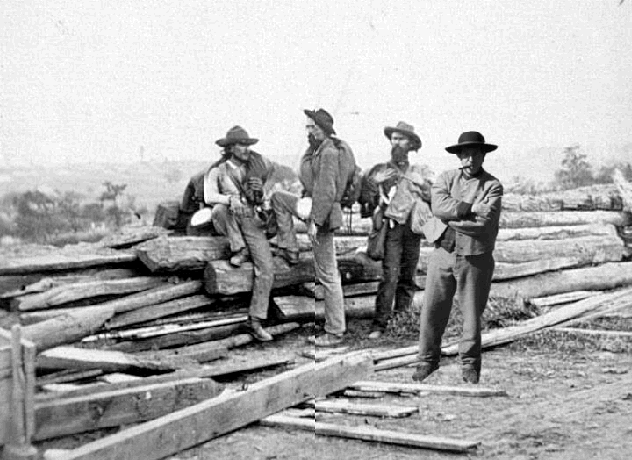 |
|
![]()